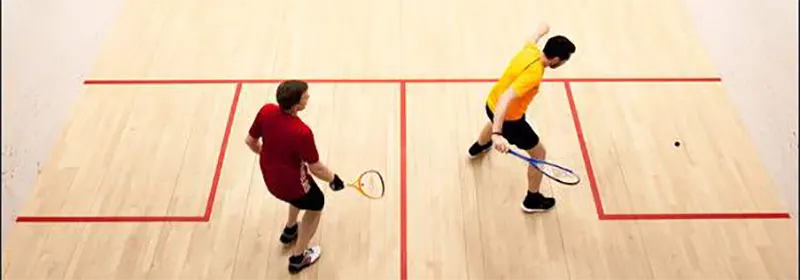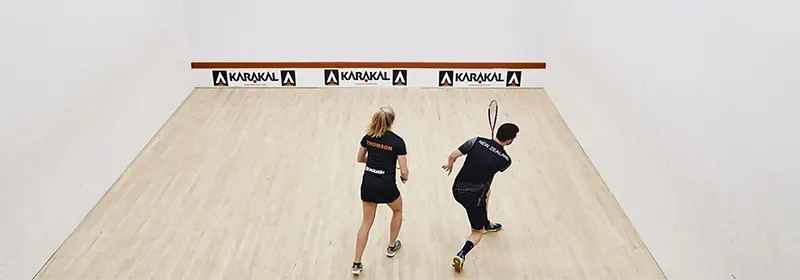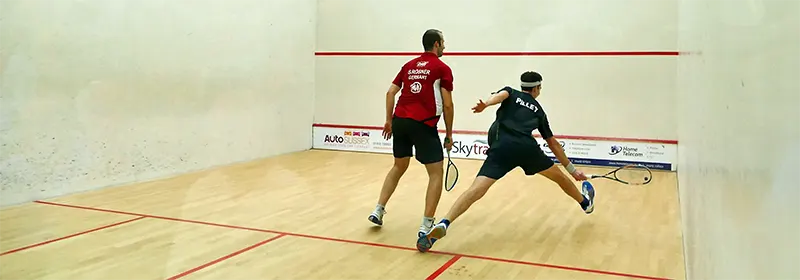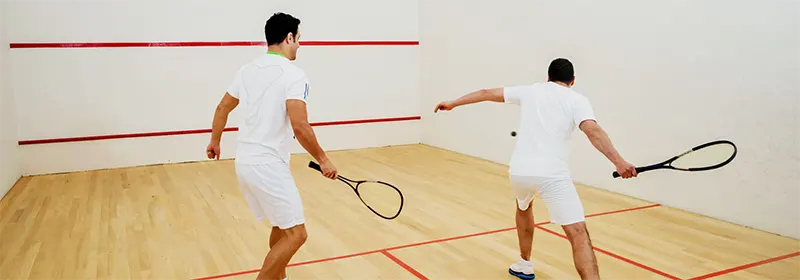05 August 2022 / 3-Min Read / Translate
Watching the video might be faster, so check that out at the end of the article if you prefer! Most of this will simply be short definitions of each word. Obviously it’s not the only one for each letter and in a few weeks, I’ll post my 2019 version. So, let’s get started!
I’m not talking about how you approach the ball with your feet, Ii’m talking about how you approach your training and practicing. You don’t have to be a great player to have a great approach.
You can take things seriously, you can plan, you can record matches and review them. It’s all about your mental attitude; that’s what I’m talking about. Honestly, I’d rather coach a player who is really focused, but less talented, than a very lazy talented player.
There are a few different boasts and you should learn what they are, when to play them and why you are playing them. The boast is one of the aspects that separate squash from many other rackets sports. You can really move your opponent around the court with a good boast. It’s also possible to play defensive boasts to give yourself time to get back to the T.
How often have you seen matches, even at professional level, where a series of points is lost consecutively? More than we should. Imagine: the score is 2-2 and then suddenly it’s 5-2 or 6-2. People lose concentration and then lose points. Concentration is a skill and you can improve it. One of the ways to improve your concentration is solo practice; just hitting the ball and concentrating all of the time can help.
Learning to do an effective drop really lengthens the whole court. If you don’t have a good drop, you’re only letting your opponent play in two-thirds of the court. You need them to be able to have to cover all of the court. so learn how to play a drop. BTW, it’s called a drop because the ball is supposed to “drop” onto the front wall. If the trajectory of the ball is straight, then it’s not really a drop.
There is nothing better than playing as many people as possible. You may have heard the old maxim “only play people who are better than you”, well it’s wrong. Playing different people, even if they are not as good as you, is one of the fastest ways to improve because you have to adapt to different conditions and you are constantly learning. I often suggest playing in local events; graded tournaments, box leagues, club nights as they expose you to players and situations your might never encounter otherwise.
Being able to glide around the court comfortably is very important. You don’t see many great players who don’t have good footwork and it’s a skill that you can learn.
Good footwork is the ability to move quickly when needed, to avoid being in the way of your opponent, to allow yourself the option of playing any different shots from most situations and not wasting effort with heavy or unstable movement. So how do you improve your footwork? See G!

He's playing his forehand on the wrong foot! But does it really matter?
Ghosting is practicing your movement and swings on the squash court, on your own by moving into the corners and pretending to play the strokes. It doesn’t have to be performed on a squash court and you can find plenty of videos of coaches showing you ghosting in all sorts of situations, but unless those situations have walls and a wooden floor, it’s just not as representative as a proper court.
How high is the squash court front wall? Do you know? Well it’s actually four and a half meters high but if you look at all of the people who play club squash, it’s almost as if they think it’s only just two meters high because they don’t use the full height of the court! To hit a high, deep shot you don’t have to hit the ball near the top of the front wall.
It all depends on where you are hitting from, but just realising that you probably don’t use the full height can be enough to change you habits. Try this conditioned game: Both players must hit every shot above the service line, with each player allowed two boasts below the service line per rally.
DON’T HIT THE BALL BECAUSE IT’S YOUR TURN: HIT THE BALL BECAUSE YOU HAVE SOMETHING VERY SPECIFIC YOU ARE TRYING TO DO WITH THE BALL. I know that sounds stupid but a lot of people don’t have the mentality of purposeful hitting.
Every single time I hit the ball, I know EXACTLY what I am trying to do with it. Do I hit with perfect accuracy all the time? Hell, no, but I hit with better accuracy than if I didn’t have any intention. Hit every shot with intention. If you don’t know what should be your intention, then get coaching or ask me.
Often called skipping, this was almost a lost art outside of boxing gyms, although it is becoming more trendy nowadays. Skipping is a fantastic exercise, and for ten dollars/euros/pounds, you can get a great skipping rope.
Just check YouTube for many, many different workouts and I suspect you will be surprised at how interesting and effective those workouts can be. Squash players, like boxers, are constantly on their toes, so being able to skip will brings noticeable improvement to your movement and reaction times. It’s a great exercise that can be performed almost anywhere.
Too often I see people keeping the ball going when they have created an opportunity. Sometimes this is because they didn’t realise that they had created the opportunity, other times because they are not sure what is the best kill shot to play and other times it’s because they lack confidence in playing the kill shot. When you create an opportunity, kill the ball. Don’t hit it to the back unless you have some long-term strategic plan. Against your nemesis create an opportunity and kill it!
Good length is one of the core foundations of great squash. It limits your opponent AND creates chances for you to take. There are many aspects of a good length, but keeping tight to the side wall if it is straight, and making it wide enough not to be easily volleyed for crosscourts are the essential requirements.
Variation of pace↗ and height is also useful. I recommend playing the “length-only” conditioned game, where each shot must bounce past the short line on the floor. It will help you develop patience and your ability to hit the ball deep.

The perfect position to hit a beautiful length.
How often have you seen somebody with a clear opportunity make a mistake? Perhaps they hit the tin, or out or even they haven’t hit the right shot. I believe that if you choose the right shot at the right time, the shot itself doesn’t have to be perfect. For example, if you play a drop when your opponent is out of position, that drop doesn’t need to be 1mm above the tin.
By selecting one of the best shots for each situation your margin of error can be greater. Think of it like this: if you have to hit a drop shot 1mm above the tin, you are either playing a professional! or it’s the wrong time to play it. Ask yourself this question: “does my opponent win most of their points from my mistakes?” because if they do, then you need to change your approach.
Who doesn’t love hitting nicks? They are visually pleasing and emphatic. When you think of your best shots in a match, 99.99% of times they will be nicks. However, I believe they are false gods. Do not follow them. Do not worship them.
They will lead you from the straight and narrow, both metaphorically and literally. I’m not saying don’t play them, I’m just asking you to realise that trying to hit too many is a high-risk game and while you might hit a few, you won’t win tournaments because of them.
Playing smart squash is about using your strengths against your opponent’s weaknesses. But how can you do that if you don’t know what your strengths and weaknesses are? What about your opponents’ strengths and weaknesses?
Well, firstly, let’s look at yours. Ideally your should record some matches on your phone and watch them to see the kind of mistakes you make and the good shots you play. The more you do it, the more accurate the assessment. As far as your opponent is concerned, just try to be as observant as possible, without detracting from your concentration.
My favourite word is practice. Practice, practice, practice! If i could get people to practice half as much time on their solo skills as they do on their fitness, people would be better squash players. Yes fitness is very important but too often it’s over emphasised because squash requires high levels of fitness.
There’s no doubt about that. But, if I could take one of the fittest people in the world and I could take an ex-professional who hasn’t played in 20 years, I know who’s going to win. Fitness comes and goes, skill is for life!
Why didn’t I win today? Why is my backhand coming into the middle of the court? Why don’t I volley enough? Question everything that you do and make sure you have a good answer. Of course, just because you know the answer, doesn’t mean suddenly everything starts working, but at least you are being proactive in your improvement.
Considering how similar tennis and squash are, it’s amazing the different mentality that we have when a squash player learns to serve. A squash player is often just putting the ball in play. Tennis players are looking to win the rally. We need to use that squash serve complacency to our advantage.
A return of serve should really take away any possible advantage and put you in the driving seat. It’s not just to hit the ball, it’s to take away their advantage. Spend one minute each week on each side of the court, standing in the back and playing high volleys to yourself. You’ll be surprised at how much more confident you will become returning serve.

Great last lunge towards the ball, good racket prep, too!
So, if R is for Return, no need to guess what S is for! When you serve as a squash player, you should be thinking about making life as difficult as possible for your opponent. You know that very few people practice their return of serve, so take advantage of that. I’m not suggesting you try to hit a lob ace, but make sure that you are not feeding them an easy shot. If you’re playing the left-hander you should start in the left box so that you serve to their backhand.
When you achieve a high degree of skill, that ability stays with you for a long time. Having high levels of skill requires excellent technique. Excellent technique requires purposeful practice. Fitness is important in squash, for sure, but I have found that having skill gives you more pleasure when playing and more options. Take time to learn the basics of each stroke and understand what is good and bad, so that you can create good habits by replacing the bad ones.
To fully understand your weaknesses you must understand why you have that weakness. In O for Observation, I talked about observing what you are good and bad at. Once you identify a weakness, you need to try to understand why you have that weakness.
For example, you observe you have a weak backhand drop. What do you do now? Stop playing it? Maybe, at least in the short term, but what about mid to long term? Well, you try to understand why you have a weak backhand drop and then go about improving it. Perhaps that means visiting a coach or perhaps it means videoing yourself and trying to assess what to change.
I played tennis for about 5 years before I tried squash. I was a serve and volleyer, meaning I tried to get to the net as soon as I created a chance. This mentality has stayed with me into squash. Volleying gives you opponent less time to recover back to the T, can force weak returns from your opponent and allow you to play attacking squash.
You don’t have to suddenly change your game, but if you could hit one more volley per game than you did the last match, that would be a good thing. There are plenty of solo and pair drills to improve your volley and I recommend starting with the simple volley block↗ video.
A lot of club players hit a lot of crosscourts. They do this because they don’t have confidence in hitting straight. If you hit a bad straight drive it almost certainly means you will be put under pressure. If you hit a bad crosscourt you might not have to work so hard. Why is that? Well firstly, not enough club players volley, so they miss opportunities.
Secondly you have more time and space to recover from a bad crosscourt. It sounds like I am advocating hitting more crosscourts! I’m not. I’m advocating hitting better width crosscourt shots. You sometimes want the ball to go directly into the corner if you opponent is out of position, but most crosscourts from the back should hit the side wall.
Yes, I struggled to find a suitable word for X. Xenogenesis means attributing a cause to a foreign body. Accepting failure is a very important part of improvement and therefore success and often I hear people saying “oh, I lost because i didn’t play very well” or “I didn’t hit the ball cleanly today“. I see those types of responses as not accepting that your opponent didn’t allow you to hit the ball cleanly, didn’t allow you to play or move well.
Perhaps you didn’t succeed because you failed to adapt to their situation. So don’t come off court and say it was your fault thinking you are being honest and feel as if you you know you’re being really heroic about it. No, no, no except that it was your opponent who stopped you from playing well.

Two beginners having fun.
Yoga or any other kind of stretching exercise is fantastic. As squash players, we generally don’t do enough stretching. It will help prevent injury and it will improve your game. If you don’t like doing it, that’s an extra reason to do it because it probably means you’re not very good at it.
Just remember that the stretching you do before and after a match is not “stretching” in the sense that it makes you more flexible. To do that you need to have specific stretching (yoga etc) sessions.
Zeal is defined as “eagerness and ardent interest in pursuit of something“. perhaps playing competitive squash ignites your passion or perhaps having coaching and seeing your improvement feeds your fire. For me, watching live professional squash always made me want to get better. Find what gives you zeal for squash and do it more often!
So there’s my A to Z of squash, 2013 edition. Hopefully you disagree with some of those ideas, in which case make a comment below and we can chat about it. Look out for the 2019 edition in a few weeks!